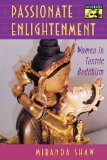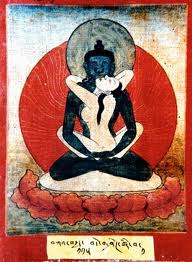Women -- and Men -- in Tantric Buddhism
 Shaw's scholarly book on the history of tantric sex isn't new
but bears re-examining periodically because of its radical and radically important insights. Since
it's hard to know where to start, let's start with her Conclusion, in which she
presents the nub of her argument for the place of passion in spiritual pursuits: Shaw's scholarly book on the history of tantric sex isn't new
but bears re-examining periodically because of its radical and radically important insights. Since
it's hard to know where to start, let's start with her Conclusion, in which she
presents the nub of her argument for the place of passion in spiritual pursuits:
"Originally the Buddha taught a life
of renunciation and celibacy as the ideal pattern for pursuing enlightenment, yet in the Tantric movement in India
we find people pursuing a different pattern . . . This [Tantric paradigm] represents
a lofty idealism, a belief that men and women together can create relationships
that are non-exploitative, non-coercive, and mutually enlightening. Shaw's scholarly book
might help Buddhists who live with a significant other create tantric relationships. Even
if we can't achieve her "lofty idealism" as couples, it never hurts to have
a target in mind. If we never had even a thought about enlightenment,
it's doubtful we would be on the path. The subtitle of "Passionate
Enlightenment" is Women in Tantric Buddhism; Shaw's main bone of contention
is that instead of being sex objects for male yogis in the Tantric movement in India,
Buddhist women in India were tantra teachers, co-creators if not leaders. Why
is this important and why should anyone care now? While it might seem
an arcane argument to modern Buddhists, "Passionate Enlightenment" makes numerous points that are highly relevant
in male-female relations, even today. What is the single most challenging issue of most
modern relationships if not our sexual relations?
One of the first points she takes issue with is the perceived
picture of women "at best as marginal and subordinate and at worst as degraded and exploited." Yet much if not all this interpretation of early Tantric texts is ascribable to Western
patriarchy.  In taking the view that women were only to be used by male
yogis for the latter's spiritual enhancement, non-Buddhist scholars apparently were unable
to recognize the utter impossibility of two such mutually exclusive ideas: exploitation
and enlightenment. In taking the view that women were only to be used by male
yogis for the latter's spiritual enhancement, non-Buddhist scholars apparently were unable
to recognize the utter impossibility of two such mutually exclusive ideas: exploitation
and enlightenment. "The
Tantrics believed that self-mastery was to be tested amidst family life, the tumult
of town and marketplace, the awesome spectacles of a cremation ground, and the dangers
of isolated wilderness areas. The new breed
of Buddhists also insisted that desire, passion and ecstasy should be embraced on the religious path." "Tantric relationships are not dedicated to the ego of the man or
woman, but rather their commitment to their own enlightenment." In essence, a gyno-centric philosophy provides "a preventive and
corrective counter-weight against male attempts to elevate themselves at the expense of
women." Tantric Buddhism isn't interested
in playing ego games with either gender coming out on top, so to speak.
The core of all
feminist work is to try and restore balance in the world and in ourselves, whichever gender
we manifest in this lifetime. "Thus," Shaw writes,
"although respect for women is the cornerstone of Tantric gender relations, it has
different implications for women and men. [Tantra]
. . challenges a woman to recognize her own divinity, while it requires a man to purify
his vision."  What Tantra has to teach us is that sex is neither good nor bad, but blissful
- and empty. If
we don't grasp it, but learn to use its remarkable and powerful energies in pursuit of
enlightenment, it can help "untie the knots," as the Buddha said. Meaning our emotional afflictions,
neuroses, and just plain mean-spiritedness. How can we develop loving-kindness for all beings, or even ourselves, without
unlocking our hearts? And while some may
be able to do this in isolation, tantric lovemaking offers an alternative path for those
who can't. What Tantra has to teach us is that sex is neither good nor bad, but blissful
- and empty. If
we don't grasp it, but learn to use its remarkable and powerful energies in pursuit of
enlightenment, it can help "untie the knots," as the Buddha said. Meaning our emotional afflictions,
neuroses, and just plain mean-spiritedness. How can we develop loving-kindness for all beings, or even ourselves, without
unlocking our hearts? And while some may
be able to do this in isolation, tantric lovemaking offers an alternative path for those
who can't.
There are major dangers
for couples on the Tantric path, of course. Firstly, it requires even more compatibility than ordinary relationships, because of the extraordinary intimacy and exchange of
energies. "Tantric Buddhism represents a different cultural realm
and a novel variation on gender relations. The power that reigns in this realm
. . . is not power of domination, but a power of transformation and liberation." The above, in a nutshell, is the major prerequisite for sexual yoga, i.e., that it be undertaken for the ultimate
benefit of all sentient beings, not personal gratification. (And of course the downside is that the practice of sexual
yoga without the above positive motivation will lead, you guessed it, straight to the
hell realms.) The
Candamaharosana-tantra quotes Vajrayogini as saying "Wherever in the world a
female body is seen, That should be recognized as my body." In
other words, any denigration of women can be seen as a violation of tantric vows.
This is the first precept of a Tantric viewpoint, that without seeing women - and men - as
divine, there cannot be real spiritual advancement. And this, we would add, is the most empowering
point in a Tantric world-view. On the path to enlightenment, there
is no room for gender discrimination.
While the Tantric path is obviously a rarefied one, it is still well worth
keeping in mind if one has a passionate
nature. "By
following passion to its source, one lays bare the blissful core of the mind," Sahajayoginicinta
wrote. Even if we cannot become high-level
adepts in this life, we can dedicate our lives - and our bliss -- to the
enlightenment of all beings, because how else should we aspire to live? Paki S. Wright |
|
|

